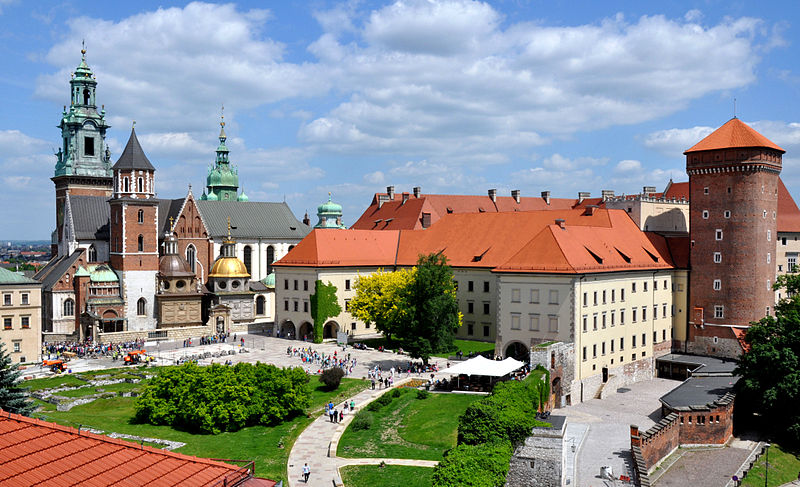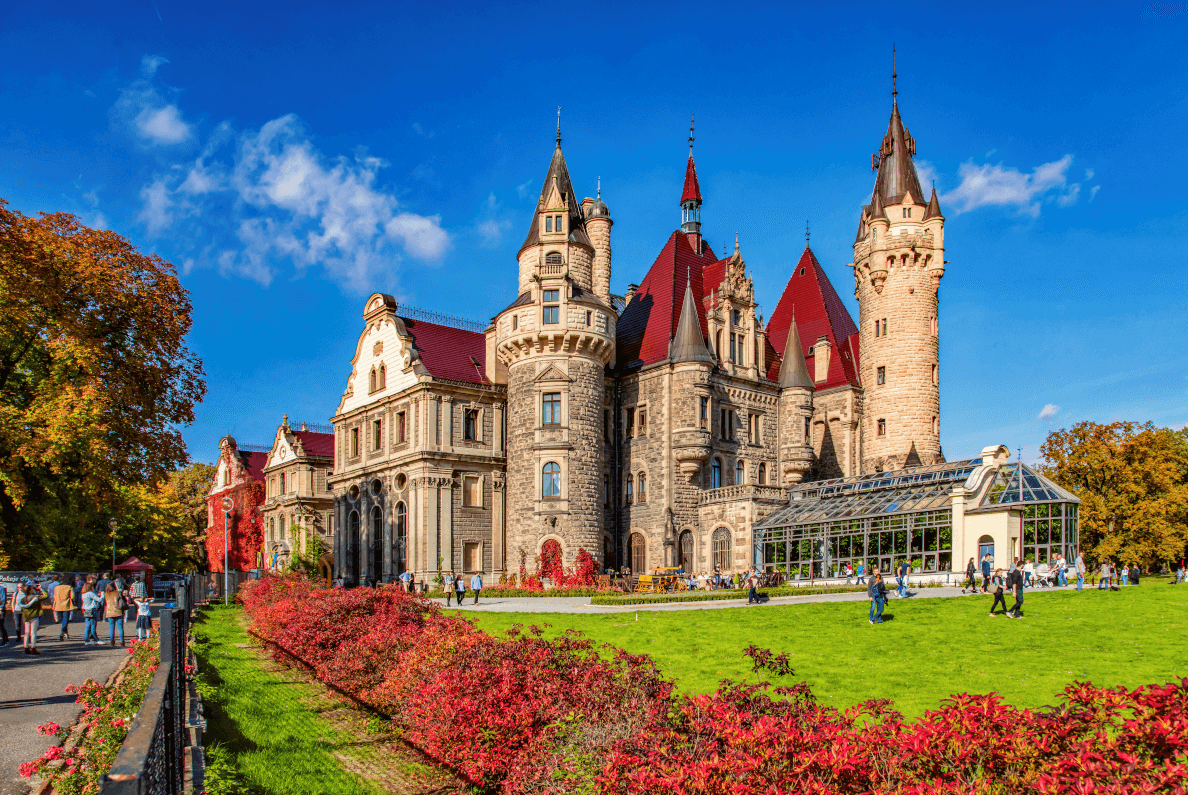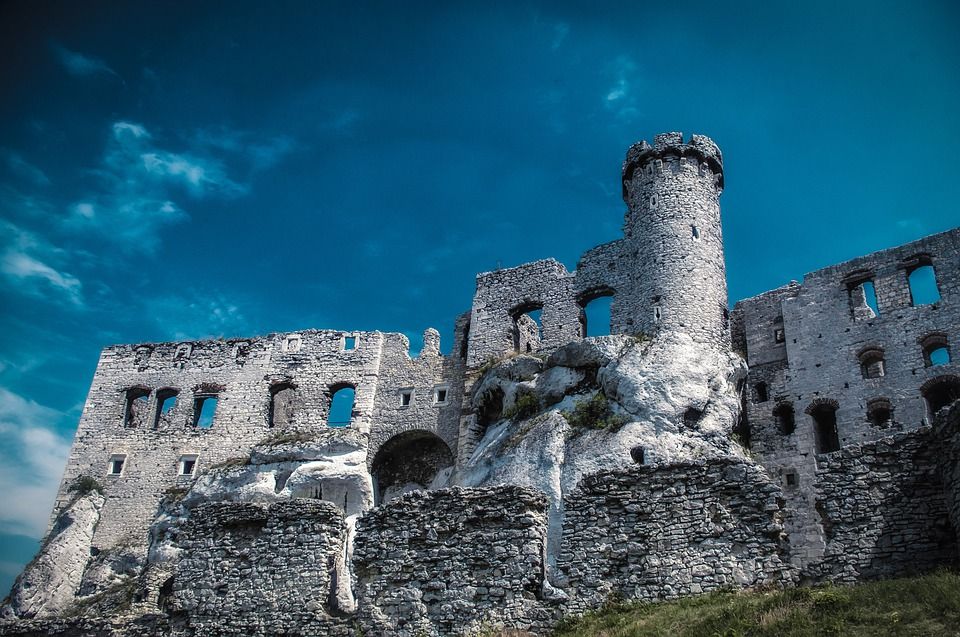Blog Article / 16 April 2022
The best castles in Poland to visit!
While not many people might know this, Poland has numerous castles. There is something interesting for everyone. Feel like you are in a fairytale in Lower-Silesia or go back to medieval times on the Trail of the Eagle's nests. Some castles are even UNESCO heritage sites!

Royal castles
Poland has many different castles and royal palaces. These were often built in the 14th-16th century, Poland’s most prosperous times by Europe’s best architects. However, in the centuries after many of these castles and palaces were repeatedly ruined, burnt, and plundered. A series of invasions caused Poland to lose its independence for a long time. Despite Poland’s tumultuous history some royal castles have been restored and are open to visitors today. The most famous Royal castles are located in Warsaw and Krakow, the current and former capital.
Royal Castle Warsaw

The Warsaw Royal Castle was the royal residence and served as the official home of Polish monarchs for centuries. It was designed to replace Wawel castle in Krakow as the seat of the King, Parliament, and the Polish-Lithuanian Commonwealth. Unfortunately, WWII brought complete destruction to the original building. In 1939 it was targeted by a Luftwaffe aircraft and caught on fire. After the Warsaw Uprising in 1944, the Nazis detonated the remains. Even though it was completely ruined, a big effort was made to rebuild the building to its original state after the war. Warsaw castle regained its original 17th-century appearance and became a UNESCO World Heritage Site after the reconstructions were finished. Book our Warsaw city tour to learn all about Warsaw Royal Castle!
Wawel castle

Wawel Castle is considered one of the most famous castles in Poland. For centuries it was the residence of the kings of Poland, and the symbol of Polish statehood. Wawel Royal Castle is situated on the Wawel hill, hence its name, and overlooks Krakow. Since the 11th-century Polish kings were crowned here, lived their lives, and were eventually buried on the same hill. The complex consists of many buildings, including Wawel Cathedral, a beautifully complex cathedral, which every successful ruler expanded. This results in what the cathedral looks like today, a cathedral with many different chapels and mausoleums, in many different building styles. Wawel hill was declared the first UNESCO World Heritage Site in the world as part of the historic center of Krakow. If you want to see more of Wawel Royal castle, and hear about the legend of the dragon of Wawel, living underneath the castle, book a guided city tour with us!
Lower-Silesia:
Lower Silesia does not only have spectacular landscapes, with green meadows and forested hilltops but within its landscapes, there are some of Poland’s most famous fairytale castles. The region is also nicknamed ‘the land of 100 palaces’. In this article, we have highlighted the most impressive castles, but we have a more extensive article available. Have any of these castles sparked your interest? Visit them on our Lower-Silesia Castle tour
Książ castle

Kziąż castle is often called ‘the pearl of Lower Silesia’ or ‘the Fairytale castle’. These expressions do not come out of thin air, it is the biggest castle in the region, built on a rock cliff and beautifully surrounded by the forest. Castles of this size are seldom built in such locations. Castle Ksiaz has over 400 rooms and was built in the 13th century. Additionally, it is one of the best castles to stay in Poland.
Moszna castle

This castle makes you believe you are in a fairytale yourself. Moszna Castle is famous for its 99 towers, and 365 rooms. Besides its size, the architecture is fairytale-like, as well as the surrounding park. According to legend, the family who built the castle had 99 estates and the count decided to express this number in the number of towers in their main residence. Nowadays, the castle has been transformed into a hotel, so besides taking a tour of the castle you can also stay in it!
Czocha castle

It might seem like a theme in the Lower Silesia region, but another castle to stay in is Czocha Castle. This medieval castle was first designed like a fortress, but after centuries of varying owners and finally a destructive fire, it was restored to its former glory by a cigar manufacturer. For all Harry Potter fans, it is sometimes referred to as the Polish Hogwarts. Czocha Castle hosts many secrets that have been hidden by its many subsequent owners, and are now ready to be discovered by the visitors of the castle.
Eagles nests trail:
If you want to feel like you are in medieval times this trail might be very interesting to you. The Trail of Eagle’s Nests is located in southwestern Poland, near Krakow. It is a marked trail, consisting of 25 medieval castles between Krakow and Częstochowa. Back in the day, it protected the southern border of Poland from intruders and enemies. Since most of the castles and strongholds are built on tall limestone rocks they are often referred to as eagle’s nests, hence the name of the trail. If you visit this trail, take a look at our all-inclusive tour!
Ogrodzieniec Castle

If you have watched the Netflix series ‘The Witcher’, you might recognize this castle. Some scenes of the series were shot here! The castle is situated on top of the highest hill of the Kraków-Częstochowa Upland. It dates back to the 12th century and was devastated and rebuilt several times over its long history. Even though it remains in ruins, most of the structures still stand, on the ground floor fragments of Renaissance frescos of lilies are still visible.
Rabsztyn castle

What is left of this Gothic fortress along the Trail of Eagle’s nests is only ruins nowadays. The name refers to its location, on top of a rock surrounded by fields and woods, a favorite spot of ravens, it literally translates to Ravens Rock. Even though only ruins are left, it is still an impressive place to visit. You can admire the breathtaking views from the towers that still stand.
Mirów castle

This impressive complex of ruins stems from the times of Casimir the Great (14th century). After changing owners multiple times the medieval castle was finally abandoned in 1787. This castle is connected to the one next on our list, not only by a rocky walking trail with great views but also by a legend. This legend tells the unlucky story of two brothers, Mir and Bobol, who once ruled each over their own castle. Unfortunately, their story takes an unhappy turn after Bobol discovers a love affair between his wife and his brother Mir. He sees no other option than to kill his brother and confine his wife to death by bricking her up in the castle tunnel. Supposedly her ghost still wanders along the castle walls.
Bobolice castle

Considered one of the most beautiful fortresses on the Trail of Eagle’s nests, Bobolice castle has a tumultuous history. The fortress has been invaded many times since its establishment in the 14th century. It has been in the hands of Poles, Czechs, Germans, and Swedish in its history. The decline began in the 16th century, with many devastations and plundering. However, in the last 13 years, the castle has been reconstructed and now hosts a restaurant, conference center, and hotel. Bobolice castle is now undoubtedly one of the symbols of the Polish Jura.
Ojców castle
Ojcow Castle is located in a small National park of only 21 square kilometers, with the same name, Ojcow National Park. The park is located near Krakow and has a sheer wealth of attractions packed into the small surface. It is characterized by steep slopes, phenomenal rock formations, and 400 registered caves. The Ocjow castle itself was constructed as a stronghold by Casimir III the Great in the 14th century. Nowadays the castle’s tower hosts a museum dedicated to the castle itself.
Other castles:
Not all castles in Poland can be divided into categories, as there are numerous, unique castles. These are the castles that deserve a visit on their own because of their exceptional beauty, perfect location, or interesting backstory!
Niedzica castle

Niedzica Castle, also known as the Dunajec Castle, is located just above the Dunajec River, at the Czorsztyn Lake. It is considered one of the most beautiful castles in Poland thanks to its perfect location. It is built on a limestone cliff at the shore of the lake and is surrounded by a breathtaking mountainous landscape. The castle was originally built as a fort defending the northern border of Hungary, remaining in the hands of Hungarian families until 1945, when it was included in Polish territory. Nowadays the interiors of the upper and middle castle have been renovated for museum purposes, and different exhibits are displayed here. If you want to see this spectacular castle from a unique point of view, take our Dunajec River rafting tour!
Malbork castle

Another UNESCO heritage site is located in Malbork. Malbork is a town in the Vistula delta, founded by the Knights of the Teutonic Order. It is known for its medieval castle, built in the 13th century as the Order’s headquarters. Inside the huge complex, you will see the Courtyard, the Cloisters of the High Castle, the Summer Refectory, and the Grand Master’s Palace. The interiors include a valuable collection of items such as armament, documents, and artistic amber wares. it is considered one of the most impressive medieval castles in Europe and is the largest castle in the world measured by land area. You can visit the castle of the Teutonic Order in Malbork easily with AB Poland in a Gdansk and Malbork day tour.
Łańcut Castle

Considered one of the most beautiful aristocratic residences in Poland is Łańcut Castle. It is famous for its excellent interiors and extremely interesting collection of horse-drawn carriages. Łańcut Castle’s interiors make you feel like 18th-century royalty, they were beautifully designed at the time, and most importantly, well preserved! Additionally, the picturesque park surrounding the castle reminds you of an English-style garden with pavilions and farm buildings for the daily life of the castle.
Kórnik Castle

Kórnik Castle was first built in the 15th century as a knightly fortress. The defensive walls and cellars are a reminder of that period. A powerful magnate Teofila Działynska particularly contributed to the growth of both Kornik town and the castle itself. She had the castle rebuilt in the baroque style and founded the French garden. According to popular legends, her ghost still haunts the castle as the so-called “White Lady“. The last magnate owner of the castle was Wladyslaw Zamoyski. In 1920 he set up the Kornik Foundation, so that the castle, especially its library could be of benefit to the local community. Since 1952 the castle, including the Kornik Library has been administered by the Polish Academy of Sciences. The castle is located just 20 kilometers south of Poznan and is one of the most frequently visited historical buildings in the Wielkopolska region. If you are ever in Poznan you cannot miss a visit to Kórnik Castle!
Blog
Lastest news from AB Poland Travel
